Impact of Social Media on Consumer Activism and Brand Response
VerifiedAdded on 2020/03/23
|8
|2334
|81
Essay
AI Summary
This essay explores the growing phenomenon of social media consumer activism, highlighting how platforms like Facebook and Twitter have empowered consumers to voice their concerns and influence corporate behavior. It examines the shift from traditional one-way communication to emotional, highly visible interactions, and the impact on brand strategies. The essay uses the 2011 Facebook boycott of cottage cheese in Israel as a case study, detailing how consumers organized to protest high prices, leading to significant price reductions and demonstrating the power of collective action facilitated by social media. The analysis covers the boycott's effects on consumer behavior, brand reputation, and government responses, underscoring the need for businesses to prioritize consumer trust and adapt to the evolving landscape of social media-driven activism. The essay also discusses the four stages of consumer engagement: awareness, affinity, advocacy, and activism and stresses the importance of building consumer trust in the face of distrust and the need for brands to have clear values. References from diverse sources support the arguments made in the essay.
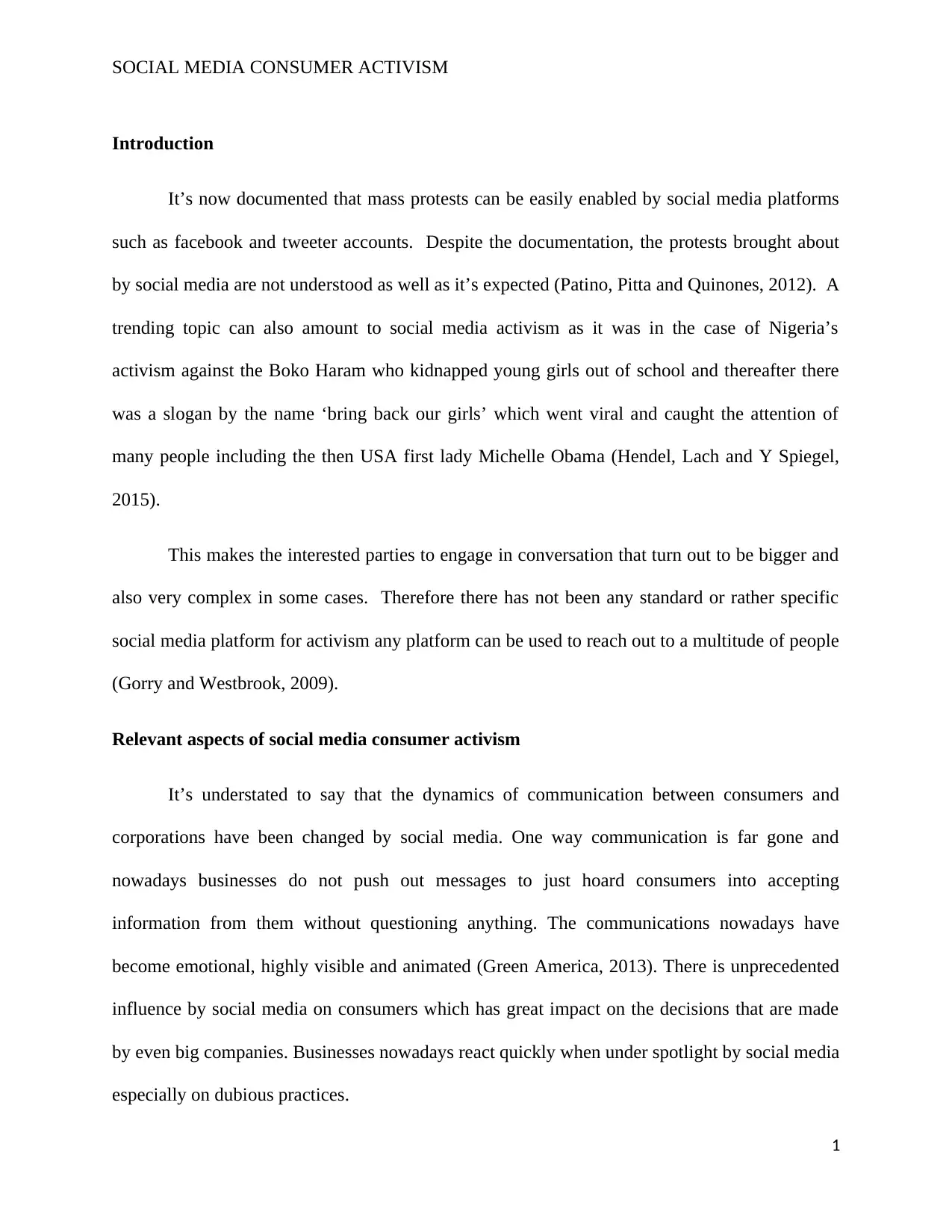
SOCIAL MEDIA CONSUMER ACTIVISM
Introduction
It’s now documented that mass protests can be easily enabled by social media platforms
such as facebook and tweeter accounts. Despite the documentation, the protests brought about
by social media are not understood as well as it’s expected (Patino, Pitta and Quinones, 2012). A
trending topic can also amount to social media activism as it was in the case of Nigeria’s
activism against the Boko Haram who kidnapped young girls out of school and thereafter there
was a slogan by the name ‘bring back our girls’ which went viral and caught the attention of
many people including the then USA first lady Michelle Obama (Hendel, Lach and Y Spiegel,
2015).
This makes the interested parties to engage in conversation that turn out to be bigger and
also very complex in some cases. Therefore there has not been any standard or rather specific
social media platform for activism any platform can be used to reach out to a multitude of people
(Gorry and Westbrook, 2009).
Relevant aspects of social media consumer activism
It’s understated to say that the dynamics of communication between consumers and
corporations have been changed by social media. One way communication is far gone and
nowadays businesses do not push out messages to just hoard consumers into accepting
information from them without questioning anything. The communications nowadays have
become emotional, highly visible and animated (Green America, 2013). There is unprecedented
influence by social media on consumers which has great impact on the decisions that are made
by even big companies. Businesses nowadays react quickly when under spotlight by social media
especially on dubious practices.
1
Introduction
It’s now documented that mass protests can be easily enabled by social media platforms
such as facebook and tweeter accounts. Despite the documentation, the protests brought about
by social media are not understood as well as it’s expected (Patino, Pitta and Quinones, 2012). A
trending topic can also amount to social media activism as it was in the case of Nigeria’s
activism against the Boko Haram who kidnapped young girls out of school and thereafter there
was a slogan by the name ‘bring back our girls’ which went viral and caught the attention of
many people including the then USA first lady Michelle Obama (Hendel, Lach and Y Spiegel,
2015).
This makes the interested parties to engage in conversation that turn out to be bigger and
also very complex in some cases. Therefore there has not been any standard or rather specific
social media platform for activism any platform can be used to reach out to a multitude of people
(Gorry and Westbrook, 2009).
Relevant aspects of social media consumer activism
It’s understated to say that the dynamics of communication between consumers and
corporations have been changed by social media. One way communication is far gone and
nowadays businesses do not push out messages to just hoard consumers into accepting
information from them without questioning anything. The communications nowadays have
become emotional, highly visible and animated (Green America, 2013). There is unprecedented
influence by social media on consumers which has great impact on the decisions that are made
by even big companies. Businesses nowadays react quickly when under spotlight by social media
especially on dubious practices.
1
Paraphrase This Document
Need a fresh take? Get an instant paraphrase of this document with our AI Paraphraser
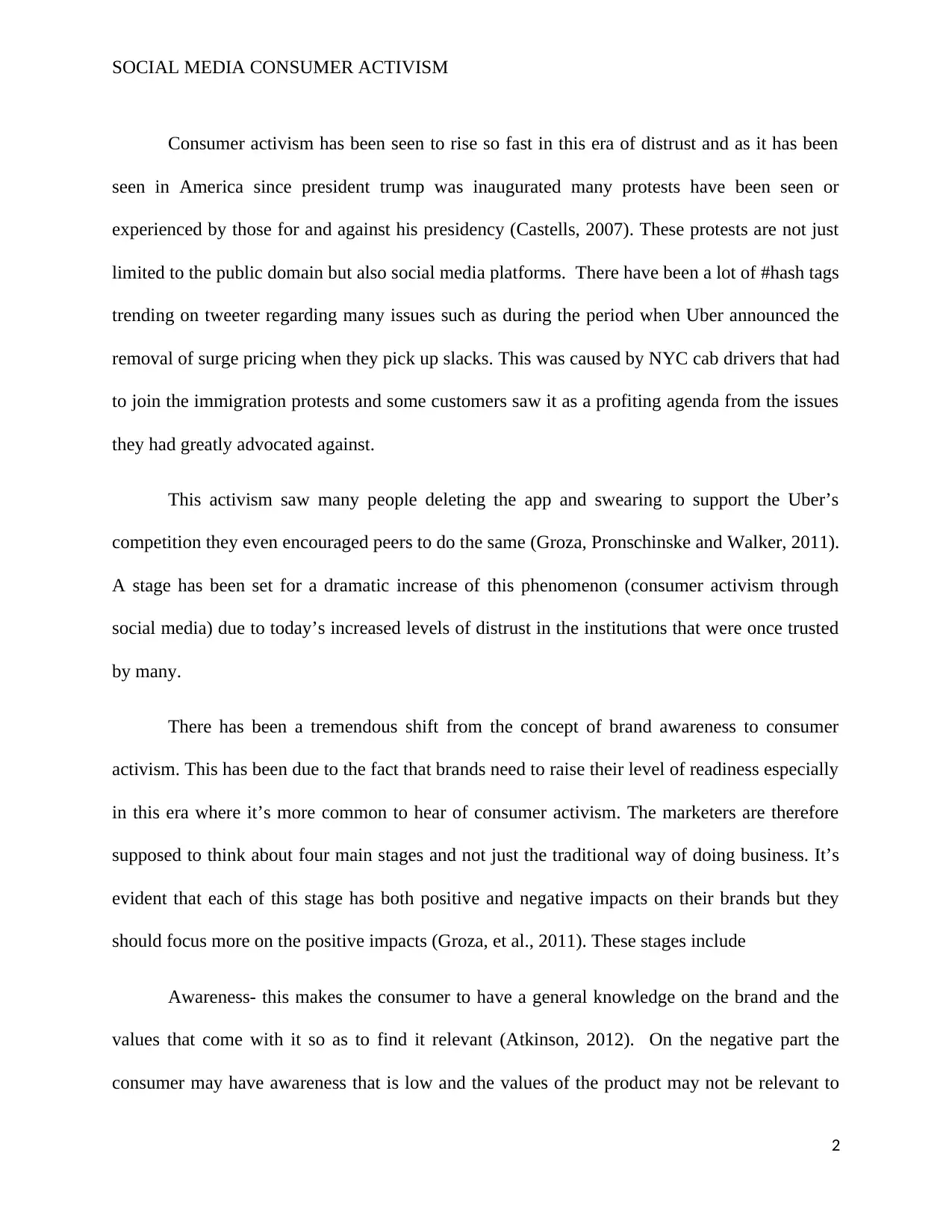
SOCIAL MEDIA CONSUMER ACTIVISM
Consumer activism has been seen to rise so fast in this era of distrust and as it has been
seen in America since president trump was inaugurated many protests have been seen or
experienced by those for and against his presidency (Castells, 2007). These protests are not just
limited to the public domain but also social media platforms. There have been a lot of #hash tags
trending on tweeter regarding many issues such as during the period when Uber announced the
removal of surge pricing when they pick up slacks. This was caused by NYC cab drivers that had
to join the immigration protests and some customers saw it as a profiting agenda from the issues
they had greatly advocated against.
This activism saw many people deleting the app and swearing to support the Uber’s
competition they even encouraged peers to do the same (Groza, Pronschinske and Walker, 2011).
A stage has been set for a dramatic increase of this phenomenon (consumer activism through
social media) due to today’s increased levels of distrust in the institutions that were once trusted
by many.
There has been a tremendous shift from the concept of brand awareness to consumer
activism. This has been due to the fact that brands need to raise their level of readiness especially
in this era where it’s more common to hear of consumer activism. The marketers are therefore
supposed to think about four main stages and not just the traditional way of doing business. It’s
evident that each of this stage has both positive and negative impacts on their brands but they
should focus more on the positive impacts (Groza, et al., 2011). These stages include
Awareness- this makes the consumer to have a general knowledge on the brand and the
values that come with it so as to find it relevant (Atkinson, 2012). On the negative part the
consumer may have awareness that is low and the values of the product may not be relevant to
2
Consumer activism has been seen to rise so fast in this era of distrust and as it has been
seen in America since president trump was inaugurated many protests have been seen or
experienced by those for and against his presidency (Castells, 2007). These protests are not just
limited to the public domain but also social media platforms. There have been a lot of #hash tags
trending on tweeter regarding many issues such as during the period when Uber announced the
removal of surge pricing when they pick up slacks. This was caused by NYC cab drivers that had
to join the immigration protests and some customers saw it as a profiting agenda from the issues
they had greatly advocated against.
This activism saw many people deleting the app and swearing to support the Uber’s
competition they even encouraged peers to do the same (Groza, Pronschinske and Walker, 2011).
A stage has been set for a dramatic increase of this phenomenon (consumer activism through
social media) due to today’s increased levels of distrust in the institutions that were once trusted
by many.
There has been a tremendous shift from the concept of brand awareness to consumer
activism. This has been due to the fact that brands need to raise their level of readiness especially
in this era where it’s more common to hear of consumer activism. The marketers are therefore
supposed to think about four main stages and not just the traditional way of doing business. It’s
evident that each of this stage has both positive and negative impacts on their brands but they
should focus more on the positive impacts (Groza, et al., 2011). These stages include
Awareness- this makes the consumer to have a general knowledge on the brand and the
values that come with it so as to find it relevant (Atkinson, 2012). On the negative part the
consumer may have awareness that is low and the values of the product may not be relevant to
2
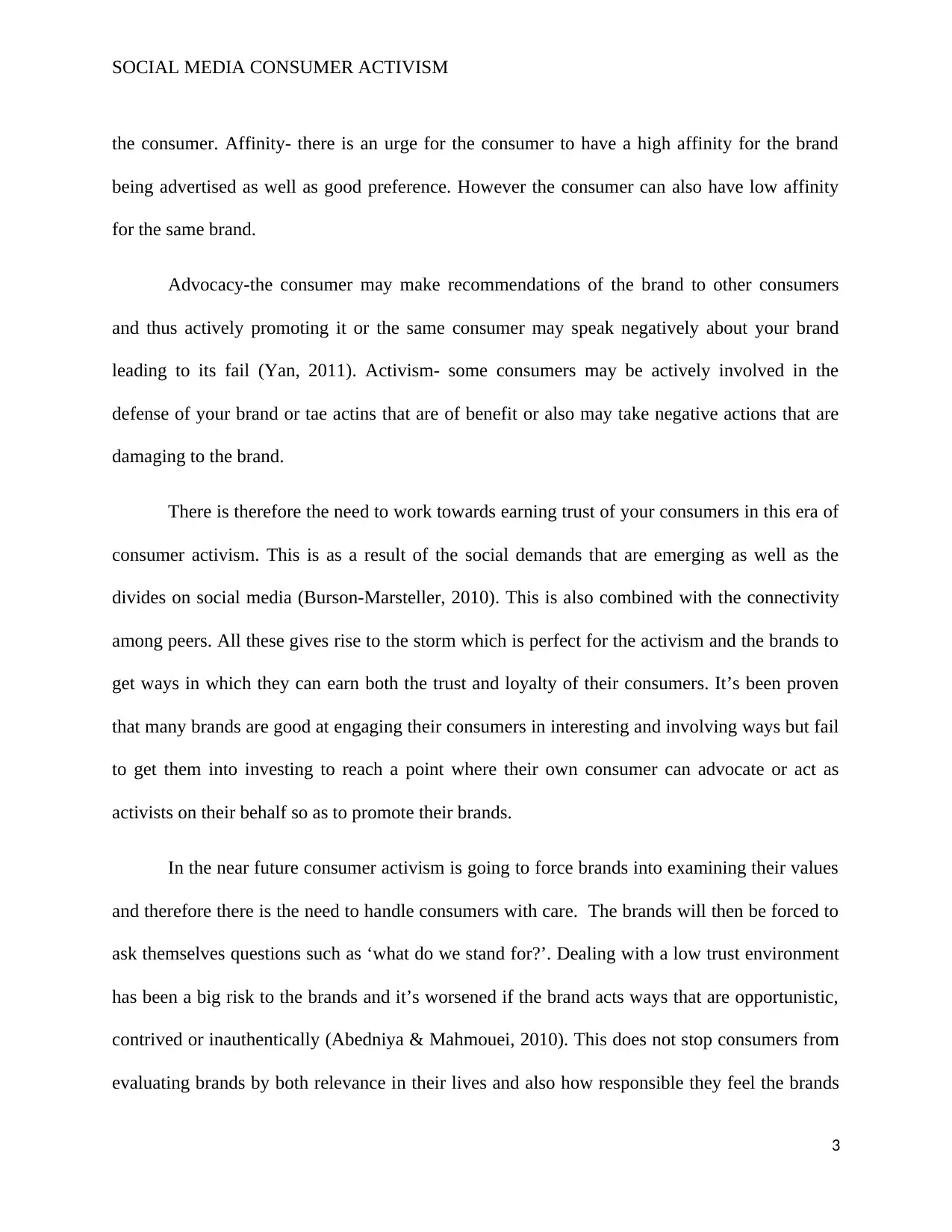
SOCIAL MEDIA CONSUMER ACTIVISM
the consumer. Affinity- there is an urge for the consumer to have a high affinity for the brand
being advertised as well as good preference. However the consumer can also have low affinity
for the same brand.
Advocacy-the consumer may make recommendations of the brand to other consumers
and thus actively promoting it or the same consumer may speak negatively about your brand
leading to its fail (Yan, 2011). Activism- some consumers may be actively involved in the
defense of your brand or tae actins that are of benefit or also may take negative actions that are
damaging to the brand.
There is therefore the need to work towards earning trust of your consumers in this era of
consumer activism. This is as a result of the social demands that are emerging as well as the
divides on social media (Burson-Marsteller, 2010). This is also combined with the connectivity
among peers. All these gives rise to the storm which is perfect for the activism and the brands to
get ways in which they can earn both the trust and loyalty of their consumers. It’s been proven
that many brands are good at engaging their consumers in interesting and involving ways but fail
to get them into investing to reach a point where their own consumer can advocate or act as
activists on their behalf so as to promote their brands.
In the near future consumer activism is going to force brands into examining their values
and therefore there is the need to handle consumers with care. The brands will then be forced to
ask themselves questions such as ‘what do we stand for?’. Dealing with a low trust environment
has been a big risk to the brands and it’s worsened if the brand acts ways that are opportunistic,
contrived or inauthentically (Abedniya & Mahmouei, 2010). This does not stop consumers from
evaluating brands by both relevance in their lives and also how responsible they feel the brands
3
the consumer. Affinity- there is an urge for the consumer to have a high affinity for the brand
being advertised as well as good preference. However the consumer can also have low affinity
for the same brand.
Advocacy-the consumer may make recommendations of the brand to other consumers
and thus actively promoting it or the same consumer may speak negatively about your brand
leading to its fail (Yan, 2011). Activism- some consumers may be actively involved in the
defense of your brand or tae actins that are of benefit or also may take negative actions that are
damaging to the brand.
There is therefore the need to work towards earning trust of your consumers in this era of
consumer activism. This is as a result of the social demands that are emerging as well as the
divides on social media (Burson-Marsteller, 2010). This is also combined with the connectivity
among peers. All these gives rise to the storm which is perfect for the activism and the brands to
get ways in which they can earn both the trust and loyalty of their consumers. It’s been proven
that many brands are good at engaging their consumers in interesting and involving ways but fail
to get them into investing to reach a point where their own consumer can advocate or act as
activists on their behalf so as to promote their brands.
In the near future consumer activism is going to force brands into examining their values
and therefore there is the need to handle consumers with care. The brands will then be forced to
ask themselves questions such as ‘what do we stand for?’. Dealing with a low trust environment
has been a big risk to the brands and it’s worsened if the brand acts ways that are opportunistic,
contrived or inauthentically (Abedniya & Mahmouei, 2010). This does not stop consumers from
evaluating brands by both relevance in their lives and also how responsible they feel the brands
3
⊘ This is a preview!⊘
Do you want full access?
Subscribe today to unlock all pages.

Trusted by 1+ million students worldwide
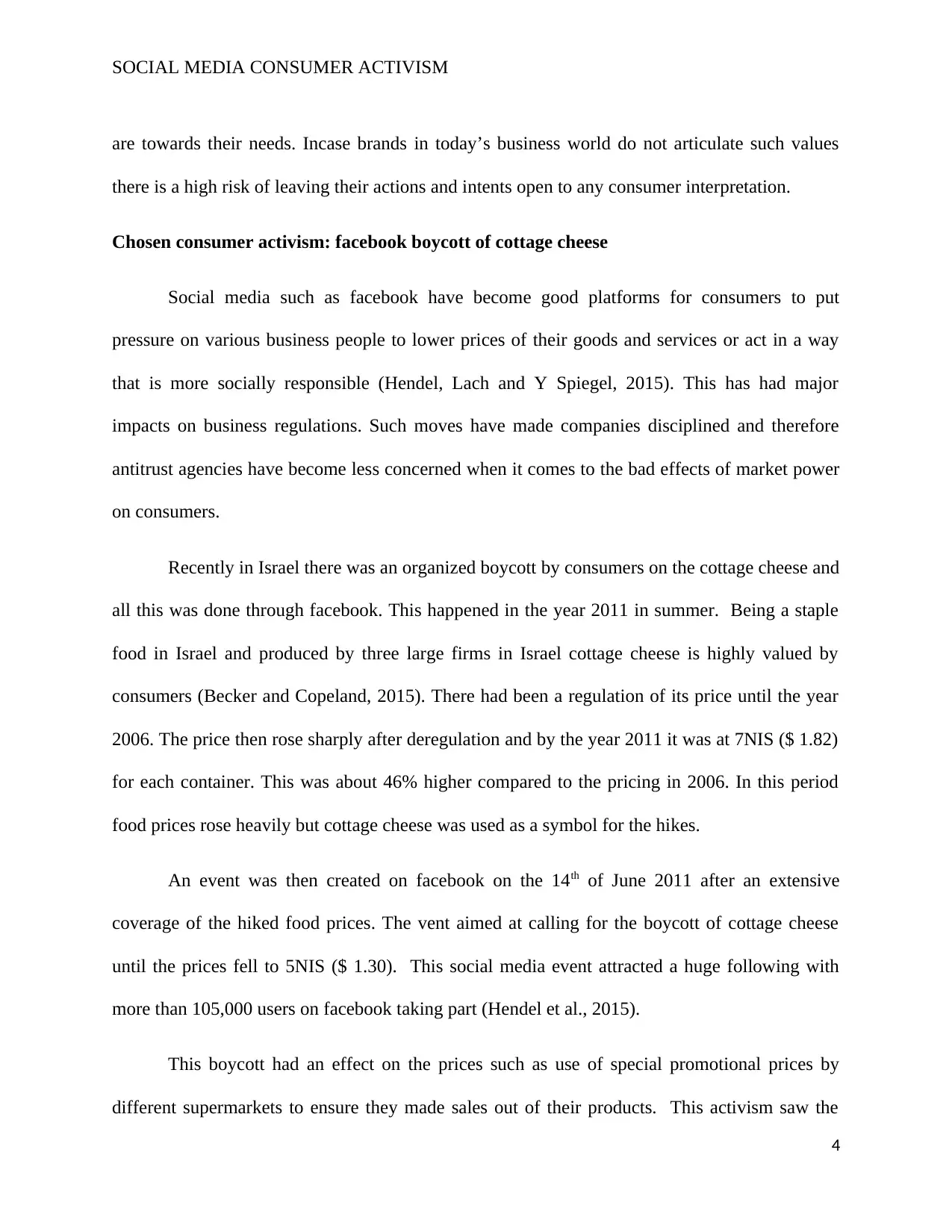
SOCIAL MEDIA CONSUMER ACTIVISM
are towards their needs. Incase brands in today’s business world do not articulate such values
there is a high risk of leaving their actions and intents open to any consumer interpretation.
Chosen consumer activism: facebook boycott of cottage cheese
Social media such as facebook have become good platforms for consumers to put
pressure on various business people to lower prices of their goods and services or act in a way
that is more socially responsible (Hendel, Lach and Y Spiegel, 2015). This has had major
impacts on business regulations. Such moves have made companies disciplined and therefore
antitrust agencies have become less concerned when it comes to the bad effects of market power
on consumers.
Recently in Israel there was an organized boycott by consumers on the cottage cheese and
all this was done through facebook. This happened in the year 2011 in summer. Being a staple
food in Israel and produced by three large firms in Israel cottage cheese is highly valued by
consumers (Becker and Copeland, 2015). There had been a regulation of its price until the year
2006. The price then rose sharply after deregulation and by the year 2011 it was at 7NIS ($ 1.82)
for each container. This was about 46% higher compared to the pricing in 2006. In this period
food prices rose heavily but cottage cheese was used as a symbol for the hikes.
An event was then created on facebook on the 14th of June 2011 after an extensive
coverage of the hiked food prices. The vent aimed at calling for the boycott of cottage cheese
until the prices fell to 5NIS ($ 1.30). This social media event attracted a huge following with
more than 105,000 users on facebook taking part (Hendel et al., 2015).
This boycott had an effect on the prices such as use of special promotional prices by
different supermarkets to ensure they made sales out of their products. This activism saw the
4
are towards their needs. Incase brands in today’s business world do not articulate such values
there is a high risk of leaving their actions and intents open to any consumer interpretation.
Chosen consumer activism: facebook boycott of cottage cheese
Social media such as facebook have become good platforms for consumers to put
pressure on various business people to lower prices of their goods and services or act in a way
that is more socially responsible (Hendel, Lach and Y Spiegel, 2015). This has had major
impacts on business regulations. Such moves have made companies disciplined and therefore
antitrust agencies have become less concerned when it comes to the bad effects of market power
on consumers.
Recently in Israel there was an organized boycott by consumers on the cottage cheese and
all this was done through facebook. This happened in the year 2011 in summer. Being a staple
food in Israel and produced by three large firms in Israel cottage cheese is highly valued by
consumers (Becker and Copeland, 2015). There had been a regulation of its price until the year
2006. The price then rose sharply after deregulation and by the year 2011 it was at 7NIS ($ 1.82)
for each container. This was about 46% higher compared to the pricing in 2006. In this period
food prices rose heavily but cottage cheese was used as a symbol for the hikes.
An event was then created on facebook on the 14th of June 2011 after an extensive
coverage of the hiked food prices. The vent aimed at calling for the boycott of cottage cheese
until the prices fell to 5NIS ($ 1.30). This social media event attracted a huge following with
more than 105,000 users on facebook taking part (Hendel et al., 2015).
This boycott had an effect on the prices such as use of special promotional prices by
different supermarkets to ensure they made sales out of their products. This activism saw the
4
Paraphrase This Document
Need a fresh take? Get an instant paraphrase of this document with our AI Paraphraser
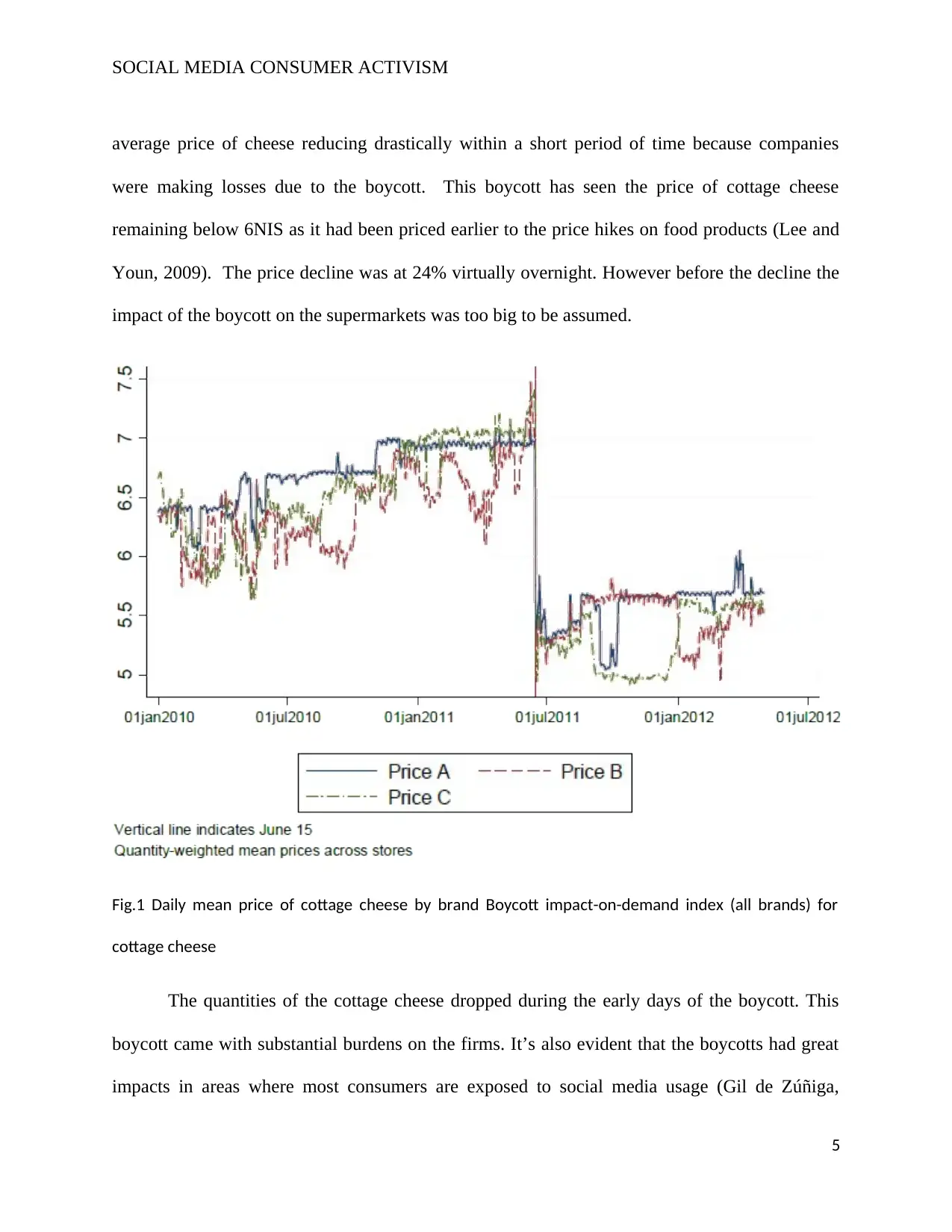
SOCIAL MEDIA CONSUMER ACTIVISM
average price of cheese reducing drastically within a short period of time because companies
were making losses due to the boycott. This boycott has seen the price of cottage cheese
remaining below 6NIS as it had been priced earlier to the price hikes on food products (Lee and
Youn, 2009). The price decline was at 24% virtually overnight. However before the decline the
impact of the boycott on the supermarkets was too big to be assumed.
Fig.1 Daily mean price of cottage cheese by brand Boycott impact-on-demand index (all brands) for
cottage cheese
The quantities of the cottage cheese dropped during the early days of the boycott. This
boycott came with substantial burdens on the firms. It’s also evident that the boycotts had great
impacts in areas where most consumers are exposed to social media usage (Gil de Zúñiga,
5
average price of cheese reducing drastically within a short period of time because companies
were making losses due to the boycott. This boycott has seen the price of cottage cheese
remaining below 6NIS as it had been priced earlier to the price hikes on food products (Lee and
Youn, 2009). The price decline was at 24% virtually overnight. However before the decline the
impact of the boycott on the supermarkets was too big to be assumed.
Fig.1 Daily mean price of cottage cheese by brand Boycott impact-on-demand index (all brands) for
cottage cheese
The quantities of the cottage cheese dropped during the early days of the boycott. This
boycott came with substantial burdens on the firms. It’s also evident that the boycotts had great
impacts in areas where most consumers are exposed to social media usage (Gil de Zúñiga,
5
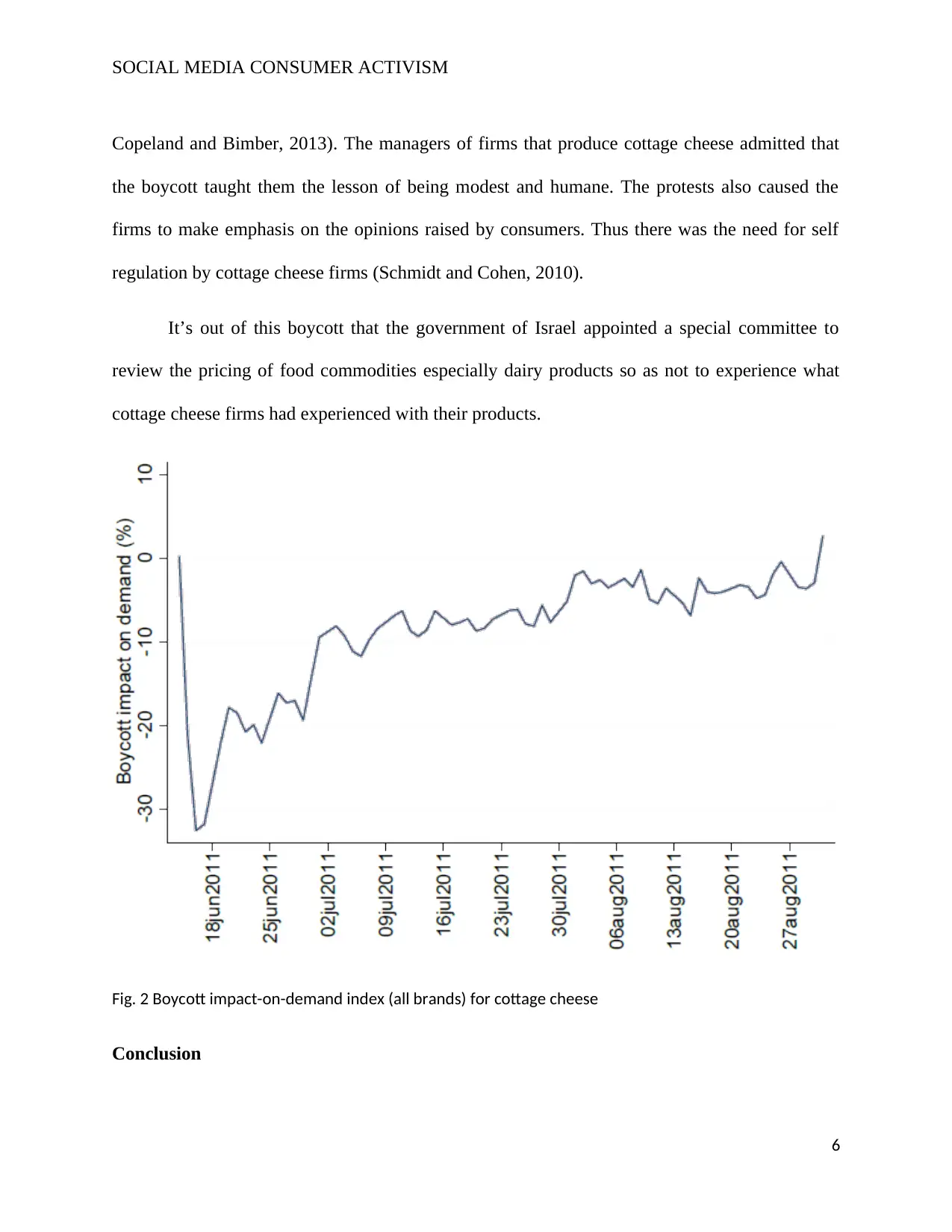
SOCIAL MEDIA CONSUMER ACTIVISM
Copeland and Bimber, 2013). The managers of firms that produce cottage cheese admitted that
the boycott taught them the lesson of being modest and humane. The protests also caused the
firms to make emphasis on the opinions raised by consumers. Thus there was the need for self
regulation by cottage cheese firms (Schmidt and Cohen, 2010).
It’s out of this boycott that the government of Israel appointed a special committee to
review the pricing of food commodities especially dairy products so as not to experience what
cottage cheese firms had experienced with their products.
Fig. 2 Boycott impact-on-demand index (all brands) for cottage cheese
Conclusion
6
Copeland and Bimber, 2013). The managers of firms that produce cottage cheese admitted that
the boycott taught them the lesson of being modest and humane. The protests also caused the
firms to make emphasis on the opinions raised by consumers. Thus there was the need for self
regulation by cottage cheese firms (Schmidt and Cohen, 2010).
It’s out of this boycott that the government of Israel appointed a special committee to
review the pricing of food commodities especially dairy products so as not to experience what
cottage cheese firms had experienced with their products.
Fig. 2 Boycott impact-on-demand index (all brands) for cottage cheese
Conclusion
6
⊘ This is a preview!⊘
Do you want full access?
Subscribe today to unlock all pages.

Trusted by 1+ million students worldwide
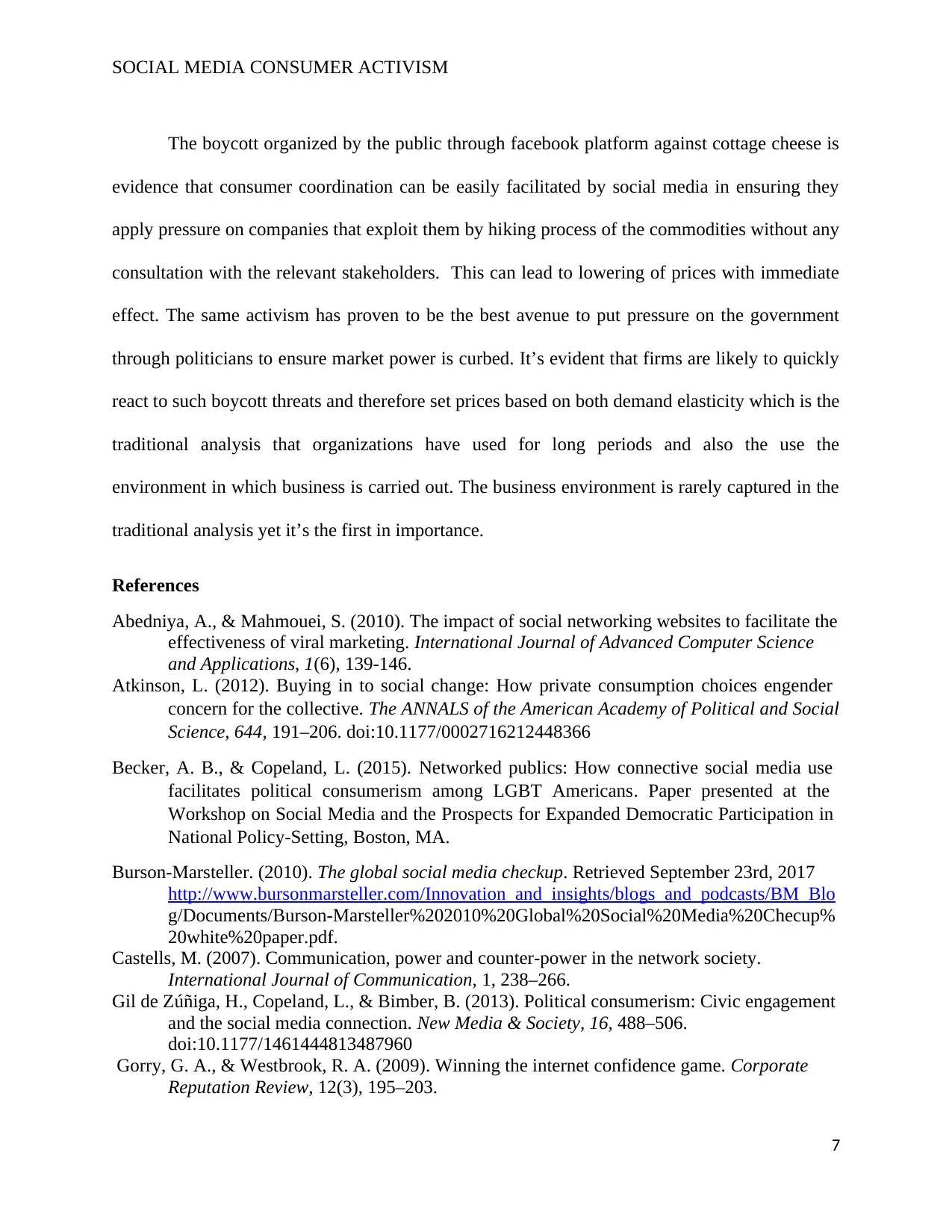
SOCIAL MEDIA CONSUMER ACTIVISM
The boycott organized by the public through facebook platform against cottage cheese is
evidence that consumer coordination can be easily facilitated by social media in ensuring they
apply pressure on companies that exploit them by hiking process of the commodities without any
consultation with the relevant stakeholders. This can lead to lowering of prices with immediate
effect. The same activism has proven to be the best avenue to put pressure on the government
through politicians to ensure market power is curbed. It’s evident that firms are likely to quickly
react to such boycott threats and therefore set prices based on both demand elasticity which is the
traditional analysis that organizations have used for long periods and also the use the
environment in which business is carried out. The business environment is rarely captured in the
traditional analysis yet it’s the first in importance.
References
Abedniya, A., & Mahmouei, S. (2010). The impact of social networking websites to facilitate the
effectiveness of viral marketing. International Journal of Advanced Computer Science
and Applications, 1(6), 139-146.
Atkinson, L. (2012). Buying in to social change: How private consumption choices engender
concern for the collective. The ANNALS of the American Academy of Political and Social
Science, 644, 191–206. doi:10.1177/0002716212448366
Becker, A. B., & Copeland, L. (2015). Networked publics: How connective social media use
facilitates political consumerism among LGBT Americans. Paper presented at the
Workshop on Social Media and the Prospects for Expanded Democratic Participation in
National Policy-Setting, Boston, MA.
Burson-Marsteller. (2010). The global social media checkup. Retrieved September 23rd, 2017
http://www.bursonmarsteller.com/Innovation_and_insights/blogs_and_podcasts/BM_Blo
g/Documents/Burson-Marsteller%202010%20Global%20Social%20Media%20Checup%
20white%20paper.pdf.
Castells, M. (2007). Communication, power and counter-power in the network society.
International Journal of Communication, 1, 238–266.
Gil de Zúñiga, H., Copeland, L., & Bimber, B. (2013). Political consumerism: Civic engagement
and the social media connection. New Media & Society, 16, 488–506.
doi:10.1177/1461444813487960
Gorry, G. A., & Westbrook, R. A. (2009). Winning the internet confidence game. Corporate
Reputation Review, 12(3), 195–203.
7
The boycott organized by the public through facebook platform against cottage cheese is
evidence that consumer coordination can be easily facilitated by social media in ensuring they
apply pressure on companies that exploit them by hiking process of the commodities without any
consultation with the relevant stakeholders. This can lead to lowering of prices with immediate
effect. The same activism has proven to be the best avenue to put pressure on the government
through politicians to ensure market power is curbed. It’s evident that firms are likely to quickly
react to such boycott threats and therefore set prices based on both demand elasticity which is the
traditional analysis that organizations have used for long periods and also the use the
environment in which business is carried out. The business environment is rarely captured in the
traditional analysis yet it’s the first in importance.
References
Abedniya, A., & Mahmouei, S. (2010). The impact of social networking websites to facilitate the
effectiveness of viral marketing. International Journal of Advanced Computer Science
and Applications, 1(6), 139-146.
Atkinson, L. (2012). Buying in to social change: How private consumption choices engender
concern for the collective. The ANNALS of the American Academy of Political and Social
Science, 644, 191–206. doi:10.1177/0002716212448366
Becker, A. B., & Copeland, L. (2015). Networked publics: How connective social media use
facilitates political consumerism among LGBT Americans. Paper presented at the
Workshop on Social Media and the Prospects for Expanded Democratic Participation in
National Policy-Setting, Boston, MA.
Burson-Marsteller. (2010). The global social media checkup. Retrieved September 23rd, 2017
http://www.bursonmarsteller.com/Innovation_and_insights/blogs_and_podcasts/BM_Blo
g/Documents/Burson-Marsteller%202010%20Global%20Social%20Media%20Checup%
20white%20paper.pdf.
Castells, M. (2007). Communication, power and counter-power in the network society.
International Journal of Communication, 1, 238–266.
Gil de Zúñiga, H., Copeland, L., & Bimber, B. (2013). Political consumerism: Civic engagement
and the social media connection. New Media & Society, 16, 488–506.
doi:10.1177/1461444813487960
Gorry, G. A., & Westbrook, R. A. (2009). Winning the internet confidence game. Corporate
Reputation Review, 12(3), 195–203.
7
Paraphrase This Document
Need a fresh take? Get an instant paraphrase of this document with our AI Paraphraser
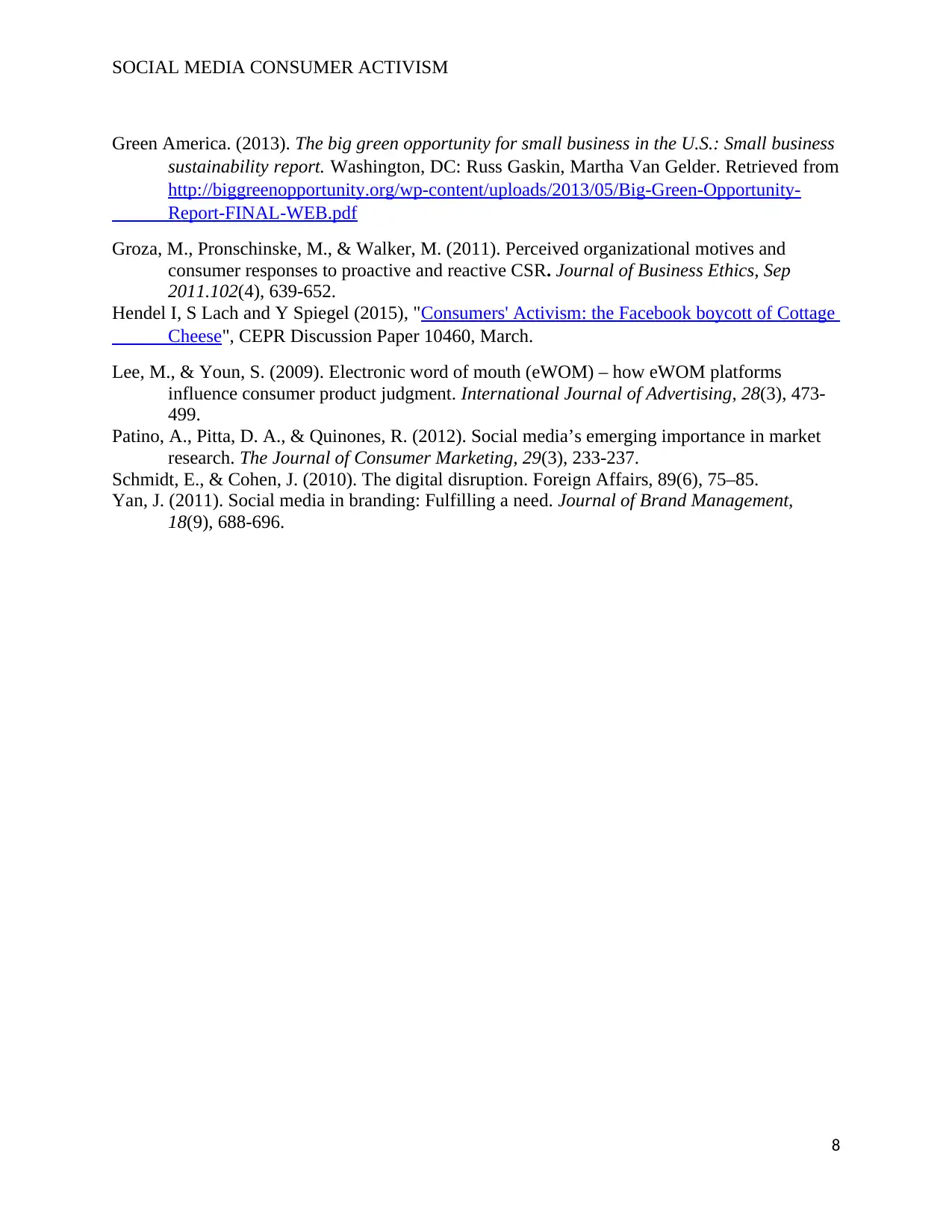
SOCIAL MEDIA CONSUMER ACTIVISM
Green America. (2013). The big green opportunity for small business in the U.S.: Small business
sustainability report. Washington, DC: Russ Gaskin, Martha Van Gelder. Retrieved from
http://biggreenopportunity.org/wp-content/uploads/2013/05/Big-Green-Opportunity-
Report-FINAL-WEB.pdf
Groza, M., Pronschinske, M., & Walker, M. (2011). Perceived organizational motives and
consumer responses to proactive and reactive CSR. Journal of Business Ethics, Sep
2011.102(4), 639-652.
Hendel I, S Lach and Y Spiegel (2015), "Consumers' Activism: the Facebook boycott of Cottage
Cheese", CEPR Discussion Paper 10460, March.
Lee, M., & Youn, S. (2009). Electronic word of mouth (eWOM) – how eWOM platforms
influence consumer product judgment. International Journal of Advertising, 28(3), 473-
499.
Patino, A., Pitta, D. A., & Quinones, R. (2012). Social media’s emerging importance in market
research. The Journal of Consumer Marketing, 29(3), 233-237.
Schmidt, E., & Cohen, J. (2010). The digital disruption. Foreign Affairs, 89(6), 75–85.
Yan, J. (2011). Social media in branding: Fulfilling a need. Journal of Brand Management,
18(9), 688-696.
8
Green America. (2013). The big green opportunity for small business in the U.S.: Small business
sustainability report. Washington, DC: Russ Gaskin, Martha Van Gelder. Retrieved from
http://biggreenopportunity.org/wp-content/uploads/2013/05/Big-Green-Opportunity-
Report-FINAL-WEB.pdf
Groza, M., Pronschinske, M., & Walker, M. (2011). Perceived organizational motives and
consumer responses to proactive and reactive CSR. Journal of Business Ethics, Sep
2011.102(4), 639-652.
Hendel I, S Lach and Y Spiegel (2015), "Consumers' Activism: the Facebook boycott of Cottage
Cheese", CEPR Discussion Paper 10460, March.
Lee, M., & Youn, S. (2009). Electronic word of mouth (eWOM) – how eWOM platforms
influence consumer product judgment. International Journal of Advertising, 28(3), 473-
499.
Patino, A., Pitta, D. A., & Quinones, R. (2012). Social media’s emerging importance in market
research. The Journal of Consumer Marketing, 29(3), 233-237.
Schmidt, E., & Cohen, J. (2010). The digital disruption. Foreign Affairs, 89(6), 75–85.
Yan, J. (2011). Social media in branding: Fulfilling a need. Journal of Brand Management,
18(9), 688-696.
8
1 out of 8
Related Documents
Your All-in-One AI-Powered Toolkit for Academic Success.
+13062052269
info@desklib.com
Available 24*7 on WhatsApp / Email
![[object Object]](/_next/static/media/star-bottom.7253800d.svg)
Unlock your academic potential
Copyright © 2020–2025 A2Z Services. All Rights Reserved. Developed and managed by ZUCOL.





